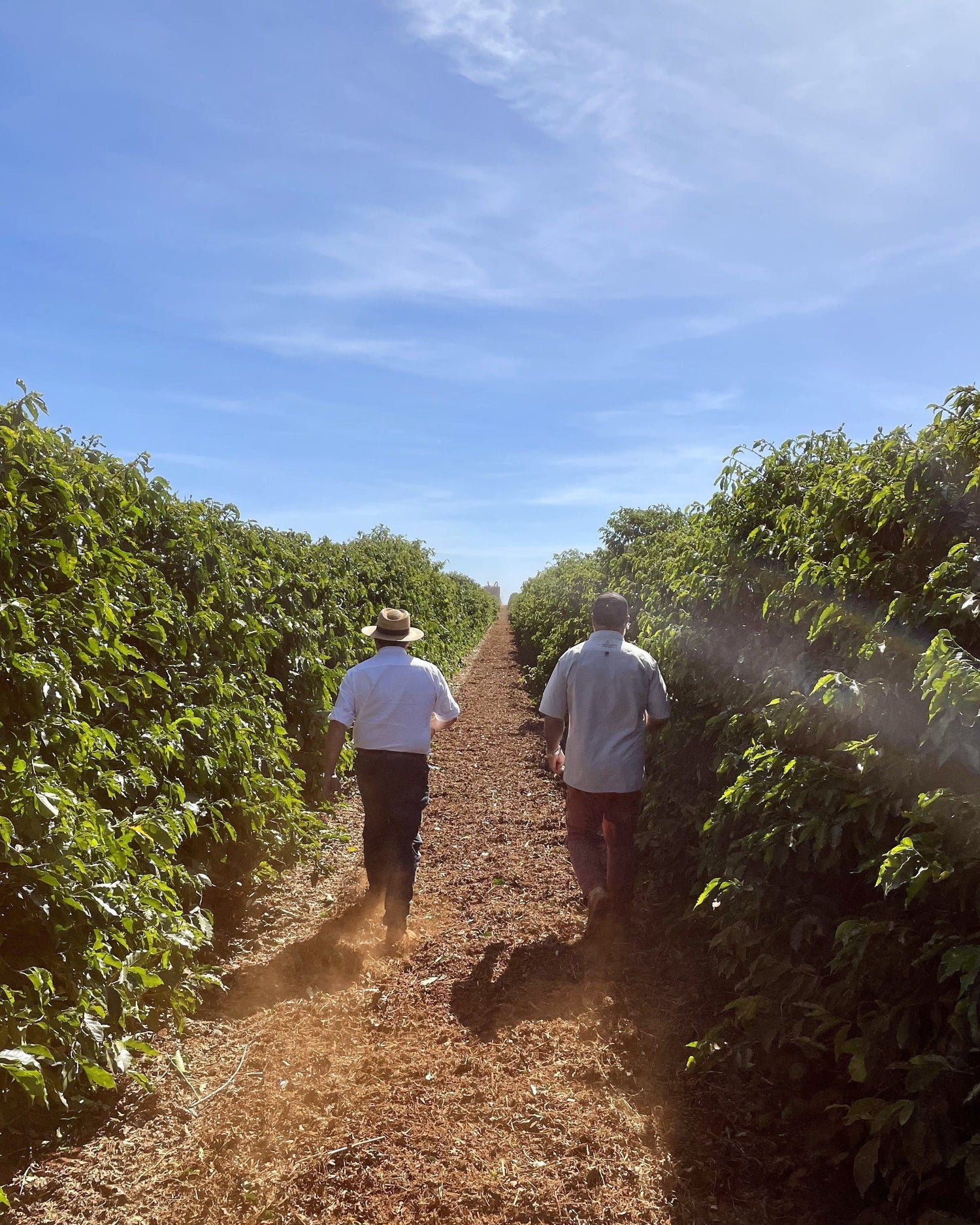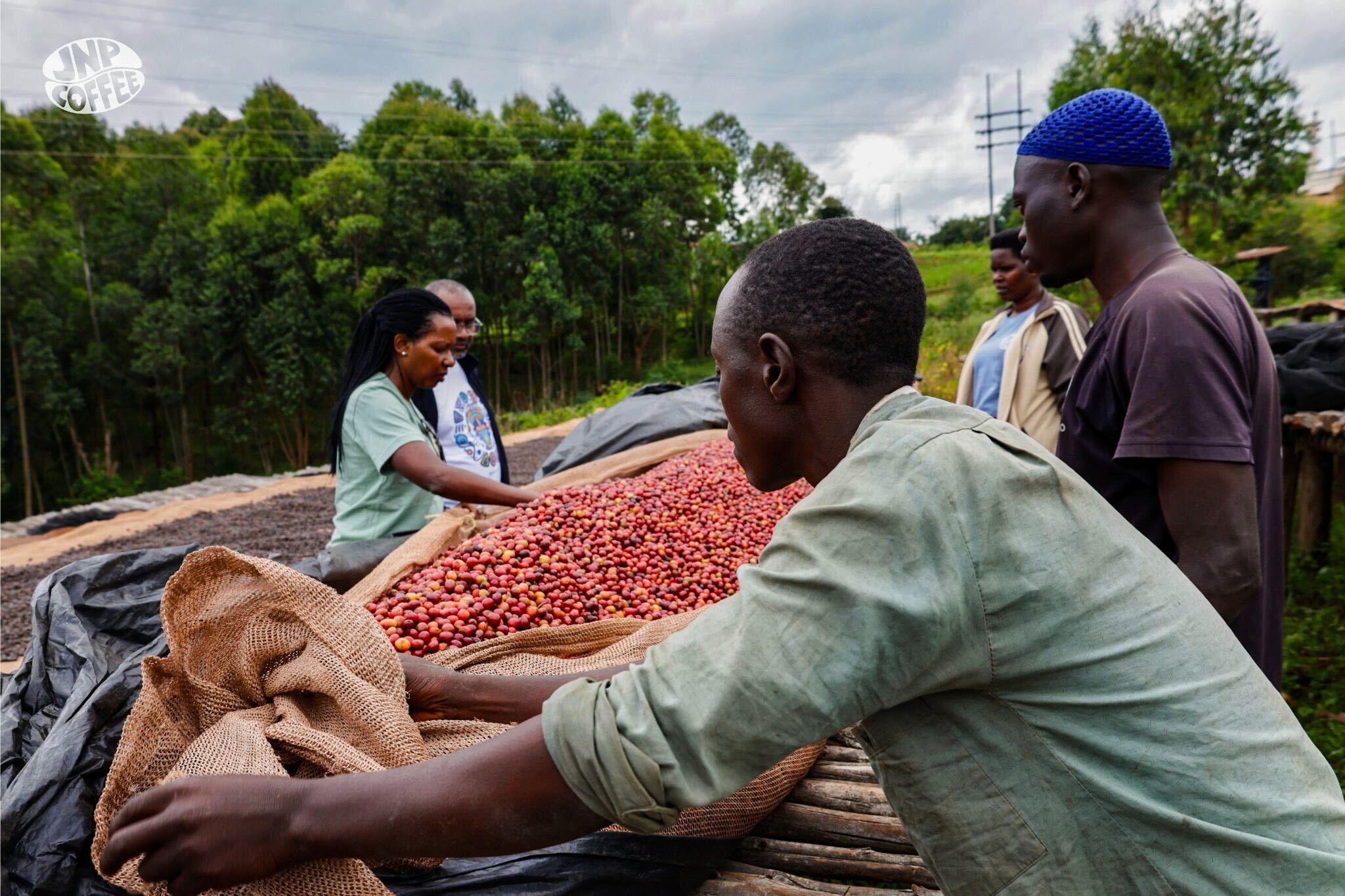Coffee can easily be mistaken as just another pantry staple, but there's so much more to the story than what's on the shelves. The journey that coffee undergoes involves centuries of history and cultivation, innovative techniques and technologies, and various teams working together to create the coffee we're familiar with today.
In this article, we'll cover plenty of the top questions we've received surrounding the farm to cup process - from growing conditions to the creation of intentional relationships at origin to the quality assurances during our roasting process.
Check out the questions below, with answers supplied by Sam, our Green Coffee Buyer:
Growing Conditions
How are climate and flavor related?
Naturally, climate is crucial to plant health. Coffee suffers from extreme heat and drought, but it can’t tolerate frost, and that alone limits its cultivation to a narrow range of elevation in the tropics. Rainfall patterns are critical too - the right amount of rain, at the right times, is necessary for coffee to foliate, flower, and bear fruit. But during the harvest season, minimal rain is desired, chiefly to facilitate successful drying. Different coffee origins experience different climates and microclimates and these can impact flavor profile and cup quality in myriad direct or indirect ways.
Elevation is closely related, and it’s best understood in the context of latitude. Together, these factors influence what is known as diurnal temperature range: the difference between the daytime high and nighttime low temperatures. As you move towards the equator, the same temperature range that’s suitable for coffee will be found at progressively higher and higher elevations, up to about 2,200 meters at the equator - that’s about five Empire State Buildings!
So, why does this matter? Warmer daytime temperatures will facilitate photosynthesis and ultimately sugar development (but please note that this does not imply sugar in the cup!), while cooler nighttime temperatures will slow the ripening of the fruit. Broadly, when it comes to flavor, the longer it takes this maturation to happen, the better!
How do producers decide which varieties to grow?
Variety selection begins with what options are realistically available. In Rwanda and Burundi, red bourbon is effectively the only option. In Colombia or Guatemala, trade groups like the FNC or Anacafé promote certain varieties like castillo and Anacafé 14 that are intentionally developed for specific circumstances, but a mix of other varieties are available as well - from older traditional varieties to novel and exotic ones.
Beyond that, it really depends - different varieties have different strengths in different situations (whether those strengths be cup quality, disease resistance, drought tolerance, or productivity). Naturally, different growers will also hold different goals. One well-capitalized farmer may be focused solely on differentiated coffees and exotic varieties; another may be interested in long term risk management and overall productivity.
In some cases, and particularly somewhere like Brazil with large farms and relatively little elevation gain, a mix of varieties might be grown to spread out labor during the harvest, as different varieties can ripen at different rates.


Does growing coffee alongside other crops impact the cup?
Potentially, yes, though not necessarily in the way you might think. It’s common to use crops like avocado or macadamia as shade trees, which impacts the coffee in an obvious way - a coffee plant grown under partial shade will receive less sunlight than one grown under full sun exposure, which can beneficially slow the maturation of the fruits. Shade trees can also help protect coffee from damaging winds and soil erosion.
Other trees, plants, and crops can also affect soil composition and hydration - legumes are often planted for their nitrogen fixing abilities, for example.
How do producers decide on a particular process for their coffees?
It’s often largely circumstantial, influenced by factors like local climate (is there a well-defined dry season?), access to water, access to equipment, and risk exposure (can you definitely find a buyer when it comes time to sell?).
To name a few examples, in Ethiopia, recent market liberalization has allowed some small-scale producers to sell their coffee individually. These are almost entirely natural process coffees, because wet mills that small are virtually nonexistent there. In Brazil, most coffee is either natural or pulped natural, except in the states of Paraná and Espírito Santo, where cold and wet conditions make drying naturals very difficult. In Costa Rica, water consumption is highly regulated - hence the prevalence of honey process coffees. If you have the opportunity to choose between these options, it can become a simple business decision: high quality natural process coffees can carry a good premium, but they’re labor intensive and fairly risky.
As consumers we think of processing in terms of what flavor it will bring to the coffee, but in another more practical sense, processing is really the strategy a coffee producer uses to eliminate the parts of the coffee we don’t consume.


How long does it take coffee to grow?
New plants generally require three to five years of growth before they become meaningfully productive. After that, they can remain highly productive for years, especially with good stewardship.
Is harvesting usually mechanized or done by hand?
Most coffee producers have limited options: in places with steep or varied terrain, which describes most coffee farms, harvesting can only be done by hand. Manual harvesting can entail strip picking: removing all of the fruits from a branch in one rapid motion, with minimal regard to ripeness - or selective picking: where only the fruits ready in terms of ripeness are picked.
Hand picking requires a substantial amount of seasonal labor, and it’s hard work: we estimate a single serving of coffee in our cafes would require around 50-75 individual coffee fruits to be selectively picked.
Mechanical harvesters, more common in the flatter regions of Brazil, can be quite sophisticated - using spinning arms to shake and knock the fruits from the trees. These arms can be calibrated to different intensities depending on how selective you want to be - gentle, for a riper selection, or intense, for commercial grades that are more about volume than flavor. These mechanical harvesters are sometimes maligned, but if you have a huge and relatively level farm, they can be a higher quality option than handpicking!


Relationships
How do we decide which coffees to source?
In some ways this process is easier for us because we’re not starting from scratch - we have long term relationships with most of the producers we buy coffee from, and for the bigger volume coffees we’re mostly buying the same general types each year. If we’re buying something for the first time, we’re usually extremely intentional about sourcing it.
There’s a few factors that guide our decision making, though. We’ll usually try to be strategic with our purchases to maximize seasonality. If we need something new or interim, we’ll try to source it through our existing supply chains. If we think our sourcing needs are going to change in the upcoming year, we’ll try to have that conversation as early as possible to figure out a mutually beneficial path forward. We generally admire consistency and stability and strive to make purchasing decisions that reflect that.
For single origin coffees, we’re mostly sourcing coffees from the same producers or communities each year, but occasionally we have capacity to try something new. If that’s the case, we’ll make sure we’re fully confident that it makes sense in the broader context of our menu and sourcing philosophy.
What is the role of origin travel in sourcing?
Trips to coffee producing countries are by far the best part of my job, though it’s essential to travel with purpose. Building relationships is important and it’s valuable to see farms and processing infrastructure in person, especially to effectively communicate all the hard work that goes into coffee production and to cultivate an appreciation for the people and places involved.
Critically, travel also allows us to taste far more coffees, including lots that are actively being built. This gives us a much better selection for the year, helps us manage logistics costs with greater precision, and lets us commit to coffees before anyone else has a chance to!
How do we establish a new sourcing relationship?
If we were starting from scratch, we’d first come up with a clear idea of what we want and why we want it - it’s one thing for a coffee to taste good and another thing for it to have a logical home on our menu. Next, we’ll look at examples of other coffees or producers we admire from that region and we’ll find out if there’s anything they have in common - a region, a variety, an exporter, an importer. From there, we’ll reach out to a few different reliable sources to request samples. Depending on the time of year, we could see fresh coffees already available for sale, yet unsold samples from the previous harvest, or samples of coffees that have already been fully sold, but are kept on hand as a reference. All are useful in helping us form an idea of what we’re after - and it’s a big green flag for us if in back-to-back years, we’re finding a consistent preference for the same producers or communities, especially if we think they are a good fit for our values.
From there, we often have a pretty good sense whether a new relationship makes sense for us—then, it’s a matter of coordinating with an importer and an exporter to make logistics line up. (Sometime easier said than done.)
Roasting
How do we decide the roast level for a particular coffee?
I tend not to think in terms of roast level, but in terms of flavor profile. For our Mainstays, flavor profile is more or less fixed: we already know what flavor descriptors we’re using, we already know what recipes we’re recommending. So in roasting, the goal is to take the components we’ve sourced for those coffees and fine tune the roasting to get the results we’re targeting. Those adjustments could take the form of a higher or lower end temperature, a longer or shorter total roast time, or other changes to our overall roasting strategy. There’s a few coffees where we’re really focused on roast level - Manhattan is our most developed coffee, and we need it to match its intention - but in general, roast level is not our north star.
For the Single Origins, we have some more flexibility, as we haven’t committed to a particular long term flavor profile. In most cases, though, a lighter touch tends to capture the traits in the coffee we’re going for, and our roasting strategy is more aimed at emphasizing the flavor notes we enjoyed in our sample roasts and bringing all of the other traits into balance.
How do we keep roast levels consistent?
In addition to the very precise temperature data we monitor during roasting, we have two color tracking machines that use light refraction to give us instantaneous results before the coffee has even left the cooling tray - that way we can know right away if we hit our marks, but we can also go back and reference that score to check feedback and see long term trends.
We’ll do this for every single batch in addition to sensory evaluation to confirm what we’re seeing on the cupping table and vice versa.
Color scores aren’t the end all, be all though; other factors like processing or variety can affect the color score for a similar organoleptically-perceived roast level.
How do we measure dark/medium/light roast?
In the context of our menu, I prefer to go by subjective cupping results and use the objective color scores more to measure batch-to-batch consistency. You could still have two coffees roasted to the same color score where one tastes “roastier” than the other, and at the end of the day, you probably aren’t thinking about how much you specifically love coffees that are 55-60 point Agtron Gourmet. We don’t do much dark roasting by conventional standards, but our more developed coffees (like Manhattan) will have tasting notes of deeply caramelized sugars and very dark chocolate.


How long does coffee need to de-gas after roasting?
Please don’t drink your coffee a day off roast! Not two days, not even three days! It won’t be that good! The thing is, freshly roasted coffee still has a lot of carbon dioxide that it needs to let off, and all that carbon dioxide is going to make water less effective at extracting the flavors you actually want. I understand the desire to immediately start brewing upon receipt, but you have to resist! I recommend waiting 5 days from the roast date, and that’s because I too am impatient. 6 to 8 days is when I personally think our coffee starts to taste its best. Just don’t wait six months, please - we’re not going anywhere.
How do we decide a particular brew method/recipe for a coffee?
This is mostly trial and error! I usually won’t recommend a coffee that has a higher level of perceived acidity for espresso because it can be a little more challenging to get a balanced shot at that level of concentration. If I think a coffee is going to taste great with higher clarity and a higher extraction, I might suggest something like V60. But if we have a coffee that’s super approachable, like one with notes of milk chocolate and caramel - that’s going to be a hit with French Press, which is probably more ubiquitous anyway.
As far as recipes go, we might tweak our suggestions from time to time, but it’s only because we experimented during dial-in and found happy results!
Why are our coffees packaged the way they are? Does the packaging make a difference in the freshness?
Let’s put it this way: the circular indent on our bags isn't designed for smelling. It’s a one-way valve designed to let accumulated gas (like carbon dioxide) out, without allowing ambient gas (specifically oxygen) in. As long as the bag stays sealed, this will lengthen the amount of time the coffee will taste fresh! The best advice we can give is: just don’t open the bag until you’re ready to start brewing. If you enjoy a cup a day for two weeks after that, you’ll be in great shape to finish the bag in its entirety while it’s still tasting its best!
What other quality control checks do we perform in the roastery?
Destoning coffee is important - you don’t want a rock in your grinder! Stones are tricky - green coffee is small and dense, and it’s very, very difficult to spot small stones in a large batch of coffee, especially when you’re focused on managing the current batch in the roasting drum. But the fact of the matter is it’s an agricultural product and there’s usually rocks on and around farms.
At origin, it’s pretty much universal that coffee passes through a destoner and a magnet on its way through dry milling - along with an optical softer and machines that sort by density and size. They’re pretty effective, but they’re never perfect. We take further steps to remove rocks and foreign material in the roastery, employing additional magnets as well as our own destoner that works on roasted coffee - using vacuum pressure to separate dense rocks and the very rare bolt or washer from the much less dense roasted coffee.
Have even more questions?
Check out our FAQ page or send us an email to help@partnerscoffee.com!










Leave a comment
This site is protected by hCaptcha and the hCaptcha Privacy Policy and Terms of Service apply.